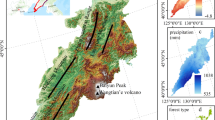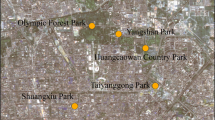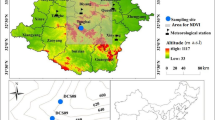Abstract
Change in plant phenology is one of the most sensitive ecological responses to climate warming. Little information is known about the effects of climate warming on phenology of urban tree species in the northern forest of China. In this study, we investigated the phenological characteristics of the main tree species in the urban forest of Shengyang City in China and the correlation between phenology and atmospheric temperature from the discontinuous data during past 42 years over three time periods (from 1962 to 1965, 1977 to 1978, and 2000 to 2005). The results showed that the annual average temperature in Shenyang City showed an increasing trend and increased by 0.96°C from 1962 to 2005 due to climate warming. The germination phenology of the urban trees was negatively correlated with the temperature in winter and early spring. The leafing phenology was mainly influenced by the temperature in spring before leafing. Influenced by climate warming, the germination, leafing, and flowering phenologies of this urban forest in 2005 were 14, 13, and 10 days earlier than those in 1962, respectively. We inferred that further warming in winter might prolong the growing season of urban trees in the northern forest of China.
Similar content being viewed by others
References
Bradley N L, Leopold C L, Ross J, 1999. Phenological changes reflect climate change in Wisconsin. PNAS, 96(17): 9701–9704. doi: 10.1073/pnas.96.17.9701
Brown M E, Beurs K M, Marshall M, 2012. Global phenological response to climate change in crop areas using satellite remote sensing of vegetation, humidity and temperature over 26 years. Remote Sensing of Environment, 126(16): 174–183. doi: 10.1016/j.rse.2012.08.009
Chen Xiao Qiu, Zhang Fu Chun, 2001. Spring phenological change in Beijing in the last 50 years and its response to climatic changes. Chinese Journal of Agrometeorology, 22(1): 1–5. (in Chinese)
Chmielewski F M, Roetzer T, 2001. Response of tree phenology to climate change across Europe. Agricultural and Forest Meteorology, 108(2): 101–112. doi: 10.1016/s0168-1923(01)00233-7
Chuine I, Kramer K, Hanninen H, 2003. Plant development models. In: Schwartz M D. (ed). Phenology: An Integrative Environmental Science. London: Kluwer Academic Publishers: 217–235.
Fang Xiuqi, Yu Weihong, 2002. A review of phenology responses to global climate warming. Advance in Earth Sciences, 17(5): 714–717. (in Chinese)
Guo L, Dai J, Wang M et al., 2015. Responses of spring phenology in temperate zone trees to climate warming: a case study of apricot flowering in China. Agricultural and Forest Meteorology, 201(15): 1–7. doi: 10.1016/j.agrformet.2014.10.016
Guo L, Dai J, Ranjitkar S et al., 2013. Response of chestnut phenology in China to climate variation and change. Agricultural and Forest Meteorology, 180: 164–172. doi: 10.1016/j.agrformet.2013.06.004
Han Chao, Zheng Jingyun, Ge Quansheng, 2007. Phenological Changes in spring in Last 40 Years in North China. Chinese Journal of Agrometeorology, 28(2): 113–117. (in Chinese)
Hannien H, 1995. Effects of climatic change on trees from cool and temperate regions: an eco-physiological approach to modeling of bud burst phenology. Canadian Journal of Botany, 73(2): 183–199. doi: 10.1139/b95-022
He Xingyuan, Chen Wei, Xu Wenduo et al., 2003. Community ecology in a typical near natural urban forest. Chinese Journal of Ecology, 22(6): 162–168. (in Chinese)
Hu Jianbo, Xu Wenduo, Chen Wei et al., 2006. Phenological analysis of main tree species in Shenyang urban forest. Chinese Journal of Ecology, 25(12): 1455–1459. (in Chinese)
IPCC (Intergovernamental Panel on Climate Change), 2007. Climate Change 2007: Synthesis Report. Contribution of working groups I, II and III to the fourth assessment report of the intergovernmental panel on climate change. In: Pachauri R K, Reisinger A (eds.) IPCC, Geneva, Switzerland.
Jiang Yundi, Ye Duzheng, Dong Wenjie, 2004. Regional climate change from the point of view of seasonality in China. Climate Change Communication, 3(2): 8–9. (in Chinese)
Kum G, Çelik M A, 2014. Impacts of global climate change on the Mediterranean Region: adana as a case study. Procedia- Social and Behavioral Sciences, 120: 600–608. doi: 10.1016/jsbspro.2014.02.140
Li Rongping, Zhou Guangsheng, Zhang Huiling, 2006. Research advances in plant phenology. Chinese Journal of Applied Ecology, 17(3): 541–54. (in Chinese)
Lu Peiling, Yu Qiang, He Qingtang, 2006. Responses of plant phenology to climate change. Acta Ecologica Sinica, 26(3): 923–929. (in Chinese)
Manciocco A, Calamandrei G, Alleva E, 2014. Global warming and environmental contaminants in aquatic organisms: the need of the etho-toxicology approach. Chemosphere, 100: 1–7. doi: 10.1016/j.chemosphere.2013.12.072
Menzel A, Fabian P, 1999. Growing season extended in Europe. Nature, 397(6721): 659. doi: 10.1038/17709
Pasgaard M, Strange N, 2013. A quantitative analysis of the causes of the global climate change research distribution. Global Environmental Change, 23(6): 1684–1693. doi: 10.1016/j.gloenvcha.2013.08.013
Penuelas J, Filella L, 2001. Phenology: responses to a warming world. Science, 294(5543): 793–795. doi: 10.1126/science.1066860
Picard G, Quegan S, Delbart N et al., 2005. Bud-burst modeling in Siberia and its impact on quantifying the carbon budget. Global Change Biology, 11(12): 2164–2176. doi: 10.1111/j.1365-2486.2005.01055
Primack RB, Ibáñez I, Higuchi H et al., 2009. Spatial and interspecific variability in phenological responses to warming temperatures. Biological Conservation, 142(11): 2569–2577. doi: 10.1016/j.biocon.2009.06.003
Schleip C, Rais A, Menzel A, 2009. Bayesian analysis of temperature sensitivity of plant phenology in Germany. Agricultural and Forest Meteorology, 149(10): 1699–1708. doi: 10.1016/j.agrformet.2009.05.014
Shen M, Zhang G, Cong N et al, 2014. Increasing altitudinal gradient of spring vegetation phenology during the last decade on the Qinghai-Tibetan Plateau. Agricultural and Forest Meteorology, 189: 71–80. doi: 10.1016/j.agrformet.2014.01.003
Sparks T H, Jeffree E P, Jeffree C E, 2000. An examination of the relationship between flowering times and temperature at the national scale using long-term phenological records from the UK. International Journal of Biometeorology, 44(2): 82–87. doi: 10.1007/s004840000049
Sparks T, Menzel A, 2013. Plant Phenology Changes and Climate Change. Encyclopedia of Biodiversity (Second Edition), 103–108.
Vitasse Y, Delzon S, Dufrêne E et al., 2009. Leaf phenology sensitivity to temperature in European trees: do within-species populations exhibit similar responses? Agricultural and Forest Meteorology, 149(5): 735–744. doi: 10.1016/j.agrformet.2008.10.019
Walkovszky A, 1998. Changes in phenology of the locust tree (Rovinia pseudoacaia L.) in Hungary. International Journal of Biometeorology, 41(4): 155–160. doi: 10.1007/s004840050069
Wan Minwei, Liu Xiuzhen, 1979. Method of Phenology Observation in China. Beijing: Science Press, 136. (in Chinese)
Wang C, Cao R, Chen J et al., 2015. Temperature sensitivity of spring vegetation phenology correlates to within-spring warming speed over the Northern Hemisphere. Ecological Indicators, 50: 62–68. doi: 10.1016/j.ecolind.2014.11.004
Xia Chuandong, Zhou Lihong, 2002. Analysis of temperature change in Shenyang of recent 50 years. Liaoning Meteorological Quarterly, 3: 15–16. (in Chinese)
Xu S, He X Y, Chen W et al., 2014. Elevated CO2 ameliorated the adverse effect of elevated O3 in previous-year and current- year needles of Pinus tabulaeformis in urban area. Bulletin of Environmental Contamination and Toxicology, 92: 733–737. doi: 10.1007/s00128-014-1246-1
Xu Wenduo, He Xingyuan, Chen Wei et al., 2008. Relationships between spring phenology of Shenyang urban forest and global climate warming in last 40 years. Chinese Journal of Ecology, 27(9): 1461–1468. (in Chinese)
Xu Wenduo, He Xingyuan, Chen Wei et al., 2006. Responses of Shenyang urban tree phenology to climate warming. Chinese Journal of Applied Ecology, 17(10): 1777–1781. (in Chinese)
Xu Wenduo, 1983. The relation between distribution of edificatory and companion in zonal vegetation and water-temperature condition in Northeast China. Acta Botanica Sinica, 25(3): 264–274. (in Chinese)
Xu Wenduo, 1986. The relation between the zonal distribution of vegetation types and the climate in northeast China. Acta Phytoecologica Geobotany Sinica, 10(4): 254–262. (in Chinese)
Xu Yuqing, Lu Peiling, Yu Qiang, 2004. Review and prospect in the researches of influence of climate change on plant phenology. Resources Science, 26(1): 129–136. (in Chinese)
Xu Yuqing, Lu Peiling, Yu Qiang, 2005. Response of tree phenology to climate change for recent 50 years in Beijing. Geographical Research, 24(3): 412–420. (in Chinese)
Yaacoubi A E, Malagi G, Oukabli A et al., 2014. Global warming impact on floral phenology of fruit trees species in Mediterranean region. Scientia Horticulturae, 180: 243–253. doi: 10.1016/j.scienta.2014.10.041
Zhang Fuchun, 1995. Effects of global warming on plant phenological events in China. Acta Geographica Sinica, 50(5): 402–410.(in Chinese)
Zhang S, Tao F, 2013. Modeling the response of rice phenology to climate change and variability in different climate zones: comparisons of five models. European Journal of Agronomy, 45: 165–176. doi: 10.1016/j.eja.2012.10.005
Zhang Xuexia, Ge Quqnsheng, Zheng Jingyun et al., 2005. Responses of spring phenology to climate changes in Beijing in last 150 years. Chinese Journal of Agrometeorology, 26(3): 263–267. (in Chinese)
Zhou L M, Tucker C J, Kaufmann R K et al., 2001. Variations in northern vegetation activity inferred from satellite data of vegetation index during 1981 to 1999. Journal of Geophysical Research, 106(D17): 20069–20083. doi: 10.1029/2000JD000115
Zhu Xubin, Liu Yamei, Sun Shucun, 2005. Leaf expansion of the dominant woody species of three deciduous oak forests in Nanjing, East China. Acta Phytoecologia Sinica, 29(1): 128–136. (in Chinese)
Author information
Authors and Affiliations
Corresponding author
Additional information
Foundation item: Under the auspices of National Natural Science Foundation of China (No. 31270518, 31170573), National Science and Technology Major Project (No. 2012ZX07202-008), National Science and Technology Support Program (No. 2012BAC05B00)
Rights and permissions
About this article
Cite this article
He, X., Xu, S., Xu, W. et al. Effects of climate warming on phenological characteristics of urban forest in Shenyang City, China. Chin. Geogr. Sci. 26, 1–9 (2016). https://doi.org/10.1007/s11769-015-0782-x
Received:
Accepted:
Published:
Issue Date:
DOI: https://doi.org/10.1007/s11769-015-0782-x




